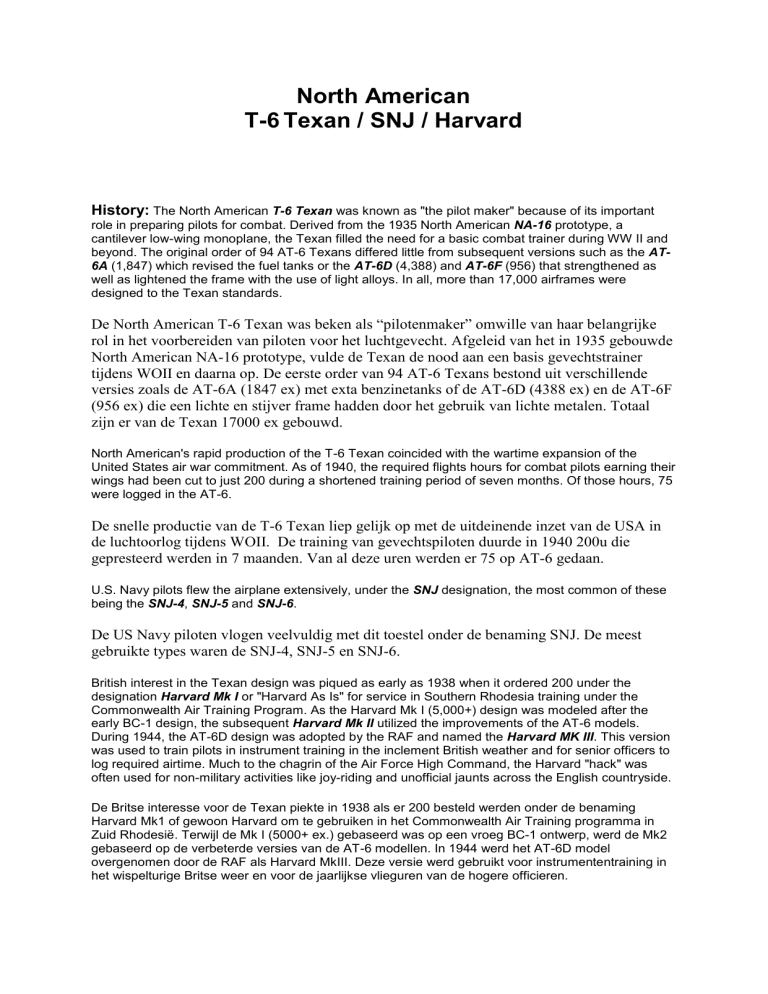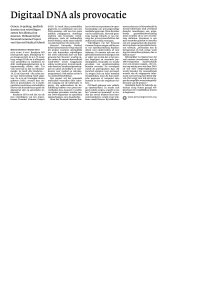
North American
T-6 Texan / SNJ / Harvard
History: The North American T-6 Texan was known as "the pilot maker" because of its important
role in preparing pilots for combat. Derived from the 1935 North American NA-16 prototype, a
cantilever low-wing monoplane, the Texan filled the need for a basic combat trainer during WW II and
beyond. The original order of 94 AT-6 Texans differed little from subsequent versions such as the AT6A (1,847) which revised the fuel tanks or the AT-6D (4,388) and AT-6F (956) that strengthened as
well as lightened the frame with the use of light alloys. In all, more than 17,000 airframes were
designed to the Texan standards.
De North American T-6 Texan was beken als “pilotenmaker” omwille van haar belangrijke
rol in het voorbereiden van piloten voor het luchtgevecht. Afgeleid van het in 1935 gebouwde
North American NA-16 prototype, vulde de Texan de nood aan een basis gevechtstrainer
tijdens WOII en daarna op. De eerste order van 94 AT-6 Texans bestond uit verschillende
versies zoals de AT-6A (1847 ex) met exta benzinetanks of de AT-6D (4388 ex) en de AT-6F
(956 ex) die een lichte en stijver frame hadden door het gebruik van lichte metalen. Totaal
zijn er van de Texan 17000 ex gebouwd.
North American's rapid production of the T-6 Texan coincided with the wartime expansion of the
United States air war commitment. As of 1940, the required flights hours for combat pilots earning their
wings had been cut to just 200 during a shortened training period of seven months. Of those hours, 75
were logged in the AT-6.
De snelle productie van de T-6 Texan liep gelijk op met de uitdeinende inzet van de USA in
de luchtoorlog tijdens WOII. De training van gevechtspiloten duurde in 1940 200u die
gepresteerd werden in 7 maanden. Van al deze uren werden er 75 op AT-6 gedaan.
U.S. Navy pilots flew the airplane extensively, under the SNJ designation, the most common of these
being the SNJ-4, SNJ-5 and SNJ-6.
De US Navy piloten vlogen veelvuldig met dit toestel onder de benaming SNJ. De meest
gebruikte types waren de SNJ-4, SNJ-5 en SNJ-6.
British interest in the Texan design was piqued as early as 1938 when it ordered 200 under the
designation Harvard Mk I or "Harvard As Is" for service in Southern Rhodesia training under the
Commonwealth Air Training Program. As the Harvard Mk I (5,000+) design was modeled after the
early BC-1 design, the subsequent Harvard Mk II utilized the improvements of the AT-6 models.
During 1944, the AT-6D design was adopted by the RAF and named the Harvard MK III. This version
was used to train pilots in instrument training in the inclement British weather and for senior officers to
log required airtime. Much to the chagrin of the Air Force High Command, the Harvard "hack" was
often used for non-military activities like joy-riding and unofficial jaunts across the English countryside.
De Britse interesse voor de Texan piekte in 1938 als er 200 besteld werden onder de benaming
Harvard Mk1 of gewoon Harvard om te gebruiken in het Commonwealth Air Training programma in
Zuid Rhodesië. Terwijl de Mk I (5000+ ex.) gebaseerd was op een vroeg BC-1 ontwerp, werd de Mk2
gebaseerd op de verbeterde versies van de AT-6 modellen. In 1944 werd het AT-6D model
overgenomen door de RAF als Harvard MkIII. Deze versie werd gebruikt voor instrumententraining in
het wispelturige Britse weer en voor de jaarlijkse vlieguren van de hogere officieren.
During 1946, the Canadian Car and Foundry company developed the Harvard Mk IV trainer to the
specifications of the T-6G and produced 285 T-6Js under the same design for the USAF Mutual Aid
Program. Designated the T-6G, the Texan saw major improvements in increased fuel capacity, an
improved cockpit layout, as well as a steerable tailwheel. U.S. Air Force and U.S. Navy forces in the
Korean War modified the Texan under the LT-6G designation and employed it in battlefield
surveillance.
In 1946 ontwikkelde de Canadese Car and Foundry company de Harvard Mk IV trainer naar de
specificities van de T-6G en produceerde 285 T-6J voor het USAF Mutual Aid programma. Als T-6G
kreeg de Texan grote verbeteringen zoals grotere benzinecapaciteit, betere cockpitinrichting,
bestuurbaar staartwiel. USAF en US Navy gebruikten de aangepaste Texan onder de typebenaming
LT-6G voor surveillance-opdrachten.
Although the US retired the T-6 from active duty by the end of the 1950's, several nations, including
Brazil, China, and Venezuela, utilized "the pilot maker" as their basic trainer well into the 1970's.
Today, over 350 T-6 Texans remain in airworthy condition. Most of the former "hacks" are based in
North America and are a reminder of the importance of simplicity in training and function
Alhoewel de US op het einde van de jaren 50 de Texan op non-actief plaatste, gebruikten talrijke
landen zoals Brazilië, China en Venezuela het toestel tot een stuk in de jaren 70 als basistrainer.
Vandaag zijn er nog meer dan 350 T-6 Texan vliegwaardig, wereldwijd. De meesten vliegen in Noord
Amerika.
Nicknames: Pilot Maker; Old Growler (USA); Window Breaker (UK); Mosquito (Korean war USAF
LT-6G Forward Air Control aircraft); J-Bird (SNJ)
Specifications (SNJ-5):
Engine: One 550-hp Pratt & Whitney R-1340-AN-1 radial piston engine
Weight: Empty 4,158 lbs., Max Takeoff 5,300 lbs.
Wing Span: 42ft. 0.25in.
Length: 29ft. 6in.
Height: 11ft. 9in.
Performance:
Maximum Speed: 205 mph
Ceiling: 21,500 ft.
Range: 750 miles
Armament: None
Number Built: 17,000+
Number Still Airworthy: 350+










